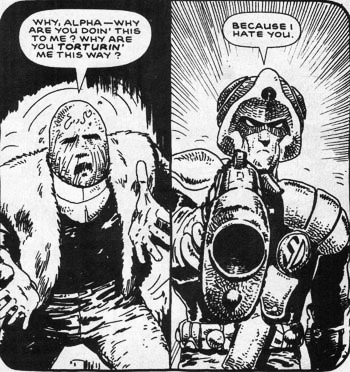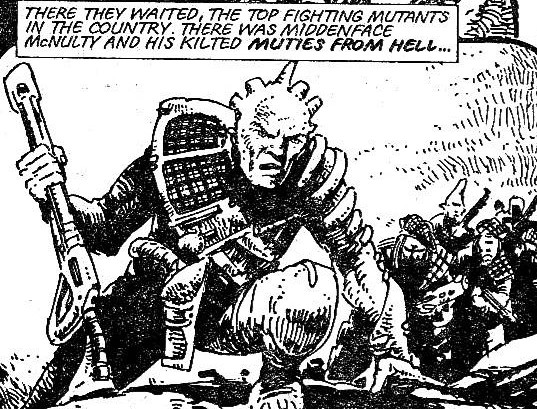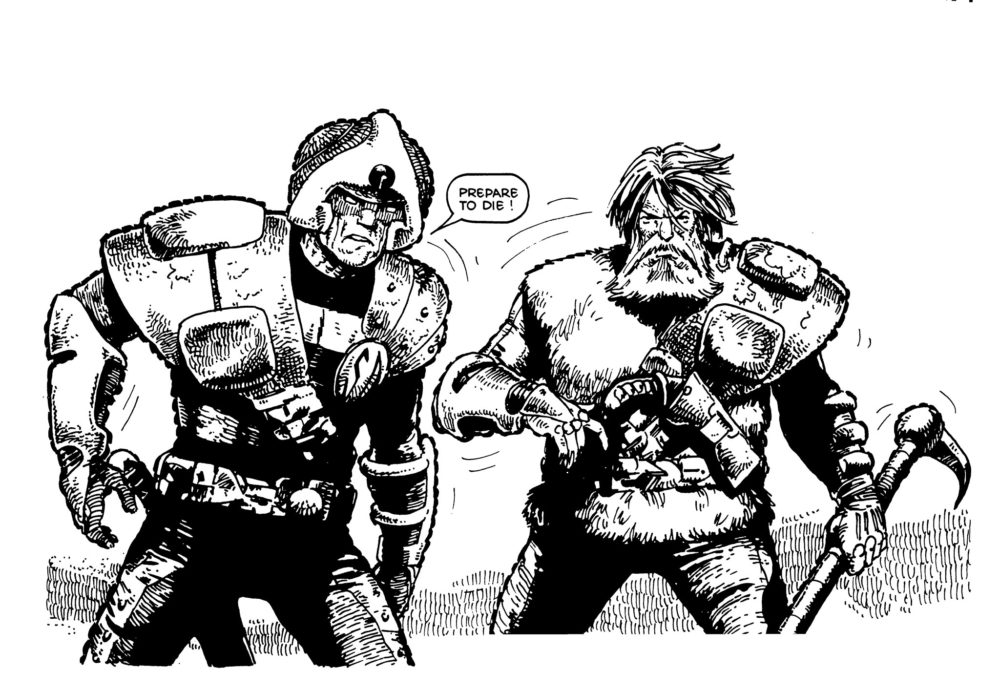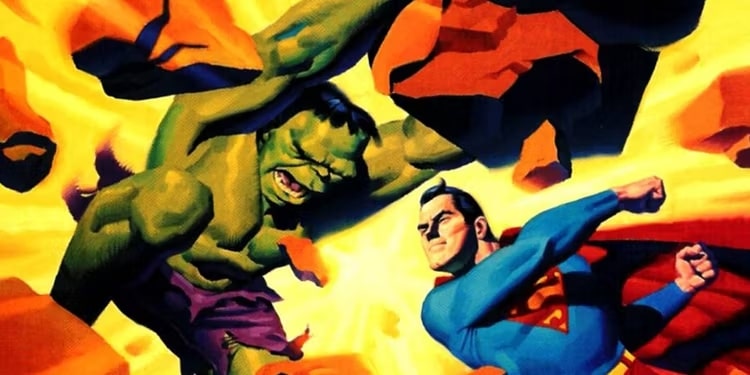Earlier this morning I was working and minding my own business when my email popped up notification that there was some news from Rebellion Publishing. Being the resident British Comics Nerd™, I never turn down a chance to talk about some 2000 AD news, but I almost jumped out of my chair when I saw that the announcement was that 2000 AD would be putting out a hardcover of my favorite mutant boys in Strontium Dog: Search and Destroy, summer of next year.
Unfortunately for the friend with whom I was chatting, our conversation was interrupted by be making excited foghorn noises at the prospect of having a full-color version of Strontium Dog in the future. All the excitement prompted them to ask me why I was having an absolute meltdown and — when I explained — they asked me one of the more frequent questions that comes up when talking about Strontium Dog:
“What the hell is a Strontium Dog?”
Hopefully that question is something that can be erased from the American comic fan’s vocabulary — because it’s time to explain exactly what Strontium Dog is.
Strontium Dog began as a strip in the UK sci-fi comic Starlord, an attempt to create an up-market version of 2000 AD from publishers IPC, with the strip treated as the cornerstone series. Created by the same creative team behind Judge Dredd, John Wagner and Carlos Ezquerra, (and later co-written by Wagner’s long-time Dredd collaborator Alan Grant), the strip fit well into its 1978 surroundings of punk rock, class warfare, and psychedelic sci-fi, but that wasn’t enough to keep Starlord going, with the title folded into 2000 AD and bringing Johnny Alpha to what would become his longtime home.
Readers would soon discover after the series started its 2000 AD run that Alpha — born as John Kreelman, son of the bigoted politician Nelson Kreelman whose power was built on the oppression of mutantkind — was the lead character of the strip, and just one of the Strontium Dogs of its title. The name came from a radioactive isotope known as Strontium-90 that had caused a massive spike in mutated births due to the nuclear fallout following the Great Nuclear War of 2150, as well as from the fact that those same mutants were forced to work as bounty hunters to escape poverty, wearing badges that read “SD” in big letters for Search and Destroy — though lets be honest, “Strontium Dog” sounds way cooler.
As a child, Johnny was discovered to have a mutation — a set of eyes able to emit alpha radiation that allow him to see through objects and read minds — transforming his childhood from one of privilege to one filled with neglect and abuse from his bigoted father. Thankfully, while still young enough to have the drive and just old enough to have the anger, young John escaped the tight grasp of his father and was welcomed into the Mutant Army, where he skyrocketed through their ranks as he claimed the name Johnny Alpha; dedicating his life to fighting on behalf of all mutants with the help of his powers and an array of memorable speciality weapons: time bombs, electrified knuckle dusters, and — his favorite — the Westinghouse Variable Cartridge Blaster.
The strip isn’t all about just Johnny, though. The space-based Search and Destroy Agency is filled with Strontium-mutated bounty hunters with names like Middenface McNulty, Durham Red, The Torso from Newcastle (who has no head, but instead a face in the middle of a human torso), and Kid Knee. In the 1990s, a number of them even received their own spin-off strips in both 2000 AD and its sister title Judge Dredd Megazine.
Not all non-mutants are considered bad, however. Like any organized revolution, there are allies like Wulf Sternhammer; a non-mutant Viking warrior who had been misplaced in time who eventually becomes Johnny’s partner, speaks with a strong Norse accent, calls everyone “cucumber” for no discernible reason, and deftly wields a large Warhammer that he refers to as his “happy stick.”
If none of that sounds strange and fun enough for you to begin with, well… clearly, it wasn’t strange enough for Wagner and Grant either. Throughout the original series’ run spanning from 1978 through 1990, Johnny goes through some pretty peculiar motions, including traveling through time to hunt down and put Adolf Hitler to trial, trapping his own father in a time loop for the rest of time, and — ultimately — grieving the death of his best friend and partner Wulf Sternhammer by going on an extended (and surprisingly violent, given the comedic tone of the rest of the strip) quest for revenge.
Following the break-up of Wagner and Grant’s writing partnership in the late 1980s, Alan Grant had taken over writing the series completely, planning to wrap up the series with a story using the on-the-nose title “The Final Solution”, Grant tried to conclude the story of Johnny Alpha by having a group of anti-mutant religious zealots possess Wulf’s body at his funeral. Johnny, unprepared for the aftermath of having to fight the reanimated corpse of his best friend and partner, ends up transported to another dimension that— for all intents and purposes — was meant to represent hell, where he ultimately meets his death. This was assumed to be the end of Strontium Dog — the lead character was dead, after all — but his original creators, it turned out, had other ideas.
Almost a decade later, and with readers still pained by how Johnny’s death came about, Wagner and Ezquerra revived the series to give the character his due via an extended flashback. (The story actually started life as Wagner’s treatment for a never-made Strontium Dog movie project.) Readers completely gobbled these stories up, leading Wagner to lean into the traditional comic book trope of magically resurrecting the character in a new run of stories running sporadically from 2012 through 2014 aptly titled The Life and Death of Johnny Alpha.
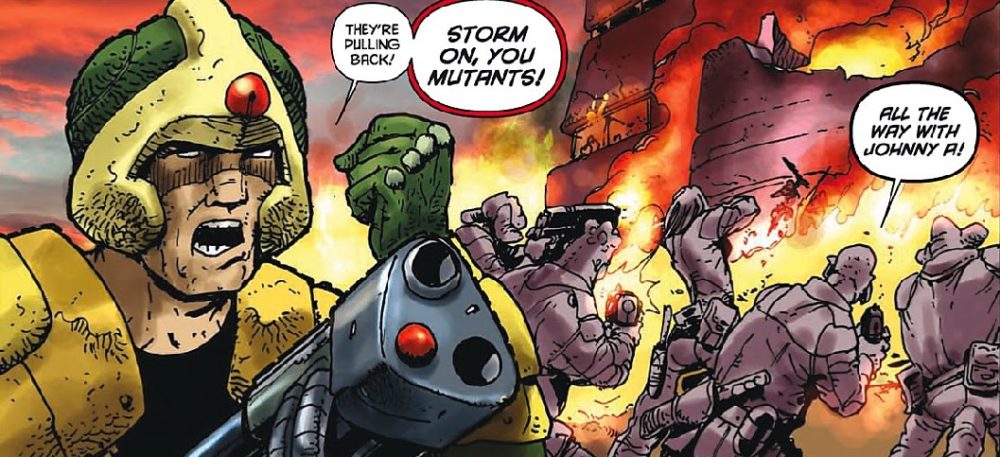
As mutants face unjust persecution – not unlike many oppressed groups in the real world or those in the pages of X-Men– it is met, not with infighting, grumbling and angst, but with mutants raising an army of fists and arming themselves with wit and humor, willing to literally push back against their oppressors and anyone who stands in their way. Despite its oddities, Strontium Dog is – at its core–one of the most pro-revolution comics to have been created, making its lack of recognition here in the U.S. all the more disappointing.
With the upcoming release of the restored color hardback in June 2020, there’s hope yet for Strontium Dog to find it’s home among an American audience that is already obsessed with mutant revolutions.
Strontium Dog: Search and Destroy will be available June 2020. In the meantime, you can catch up on everything you read in this article through 2000 AD’s digital subscription service or web store!



